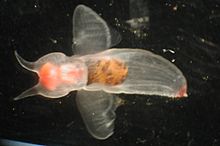- Clione limacina
-
Clione limacina 
Clione limacina Scientific classification Kingdom: Animalia Phylum: Mollusca Class: Gastropoda (unranked): clade Heterobranchia
clade Euthyneura
clade Euopisthobranchia
clade GymnosomataSuperfamily: Clionoidea Family: Clionidae Subfamily: Clioninae Genus: Clione Species: C. limacina Binomial name Clione limacina
(Phipps, 1774)Synonyms[1] Clio borealis (Pallas, 1774)
Clione limacina, common name Naked Sea Butterfly or Common Clione, is a sea angel found from the surface to 350 m[citation needed] in depth. Lives in both Arctic and Antarctic Oceans.
It was first described by Martens in 1676 and became the first gymnosomatous "pteropod" to be described.[2]
Contents
Subspecies
Distribution
Distribution of Clione limacina include mostly in cold waters, as the Arctic Ocean to North Carolina, Alaska, Canada, Northern Europe in Northern Atlantic[1] and North Pacific.[3]
They aggregate sometimes in considerable numbers before the coasts of Northern Europe.
Description
There are two races that differentiate in body length.[3] Northern race lives in colder water and its size is 70-85 mm.[3] The size of the southern race is 12 mm.[3]
The maximum recorded shell length is 40 mm.[4]
The neurobiology of this pteropod has been studied in detail.
Ecology
Clione limacina is upper epipelagic, glacial and mesopelagic animal.[1] But Welch (2010)[4] mention (incorrectly?) minimum recorded depth 0 m[4] and maximum recorded depth 0 m.[4][clarification needed]
Feeding habits
They feed in a predator-prey relationship only on the sea butterflies of the genus Limacina: on Limacina helicina and on Limacina retroversa.[3][5] The feeding process of Clione limacina is somewhat extraordinary. The buccal apparatus consists of three pairs of buccal cones. These tentacles grab the shell of Limacina helicina. When the prey is in the right position, with its shell opening facing the radula of Clione limacina, it then grasps the prey with its chitinous hooks, everted from hook sacs. Then it extracts the body completely out of its shell and swallows it whole.[citation needed]
It can survive one year without food.[6] Under such exceptional starvation in the laboratory the length of slugs have changed on average from 22.4 to 12 mm.[6]
Life cycle
Sexes are separate but are seldom conspicuously different externally, simultaneous hermaphrodites yet self-fertilization is prevented due to various morphological, physiological, or behavioral mechanisms.[1] Generally, marine gastropods shed their eggs.[1]
Clione limacina is a prey of planktonic feeders, such as the baleen whales.[3] Some fishes are also its predators.[3]
References
This article incorporates CC-BY-SA-3.0 text from the reference [1]
- ^ a b c d e f g h Gofas, S. (2011). Clione limacina. Accessed through: World Register of Marine Species at http://www.marinespecies.org/aphia.php?p=taxdetails&id=139178 on 2011-01-29
- ^ Spitzbergiscbe oder grönlandische Reisebeschreibung, p. 189, p1. P. fig. f.
- ^ a b c d e f g Böer M., Gannefors C., Kattner G., Graeve M., Hop H. & Falk-Petersen S. (2005). "The Arctic pteropod Clione limacina: seasonal lipid dynamics and life-strategy". Marine Biology 147(3): 707-717. doi:10.1007/s00227-005-1607-8.
- ^ a b c d Welch J. J. (2010). "The “Island Rule” and Deep-Sea Gastropods: Re-Examining the Evidence". PLoS ONE 5(1): e8776. doi:10.1371/journal.pone.0008776.
- ^ Lalli C. M. & Gilmer R. W. (1989). Pelagic Snails. The biology of holoplanktonic gastropod molluscs. Stanford University Press: Stanford, California. page 188.
- ^ a b Böer M., Graeve M. & Kattner G. (2006). "Exceptional long-term starvation ability and sites of lipid storage of the Arctic pteropod Clione limacina". Polar Biology 30(5): 571-580. doi:10.1007/s00300-006-0214-6.
Further reading
- http://www.seaslugforum.net/factsheet/cliolima accessed 5 January 2010
- (Danish) Boas J. E. V. (1888). "Spolia Atlantica. Bidrag til Pteropodernes. Morfologi og Systematik samt til Kundskaben om deres geografiski Udbredelse". Det Kongelige Danske videnskabernes selskabs skrifter. København, serie 6, number 4: 1-231. Pages 162-166. Plate 7, figure 101-103.
- Conover R. J. & Lalli C. M. (1972). "Feeding and growth in Clione limacina (Phipps), a pteropod mollusc". Journal of Experimental Marine Biology and Ecology 9(3): 279-302. doi:10.1016/0022-0981(72)90038-X.
- Falk-Petersen S., Sargent J. R., Kwasniewski S., Gulliksen B. & Millar R.-M. (2001). "Lipids and fatty acids in Clione limacina and Limacina helicina in Svalbard waters and the Arctic Ocean: trophic implications". Polar Biology 24(3): 163-170. doi:10.1007/s003000000190.
- Gilmer R. W. & Lalli C. M. (1990). "Bipolar variation in Clione, a gymnosomatous pteropod". Am. Malacol. Union Bull. 8(1): 67-75.
- Gosliner T. (1987). Nudibranchs of southern Africa: A guide to Opisthobranch molluscs of southern Africa. Sea Challengers, Monterey. ISBN 0-930118-13-8
- Hermans C. O. & Satterlie R. A. (1992). "Fast-Strike Feeding Behaviour in a Pteropod Mollusk, Clione limacina Phipps". The Biological bulletin, Marine Biological Laboratory, 182: 1-7.
- Morton J. E. (1958). "Observations on the gymnosomatous pteropod Clione limacina (Phipps)". Journal of the Marine Biological Association of the United Kingdom 37: 287-297.
- Rosenthal J. J. C., Seibel B. A., Dymowska A. & Bezanilla F. (2009). "Trade-off between aerobic capacity and locomotor capability in an Antarctic pteropod". Proceedings of the National Academy of Sciences of the United States of America 106: 6192-6196. doi:10.1073/pnas.0901321106, PubMed, PMC PMC2669364
External links
- Clione limacina at National Center for Biotechnology Information (NCBI) website.
Categories:
Wikimedia Foundation. 2010.

